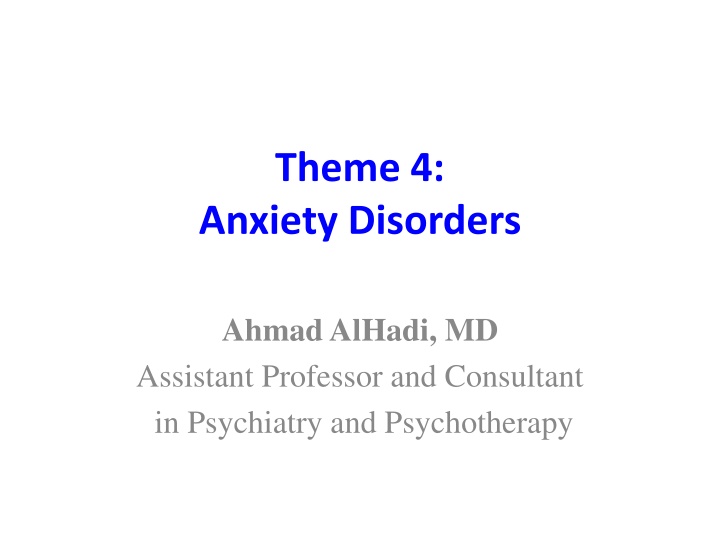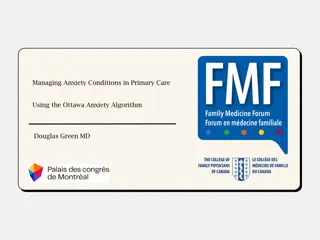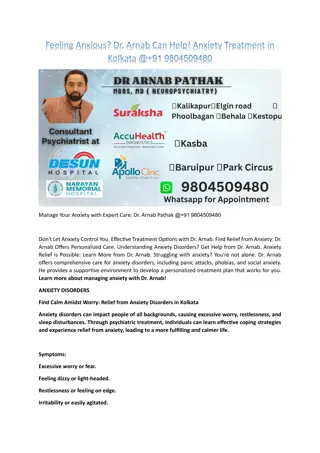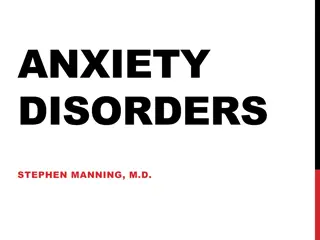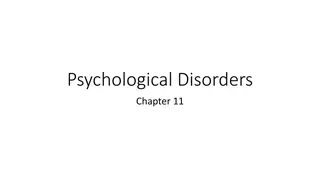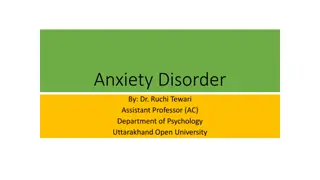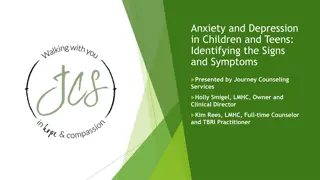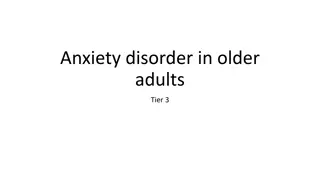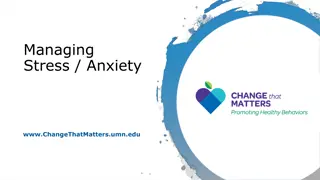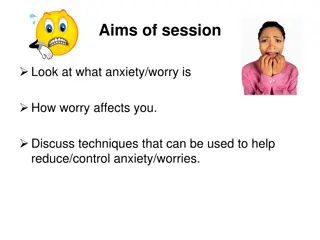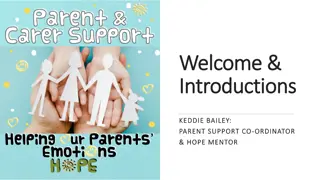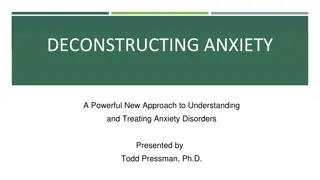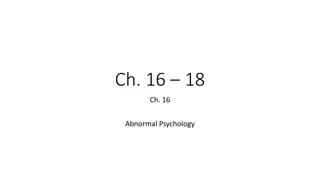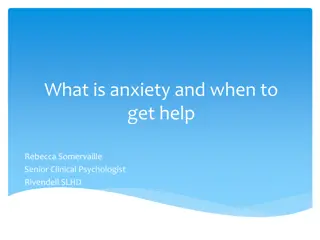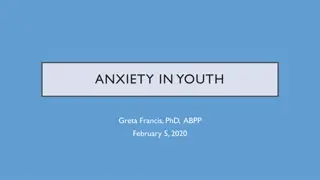Anxiety Disorders: Understanding Symptoms and Treatments
Dive into the world of anxiety disorders with a focus on symptoms, types, and case vignettes. Learn about the psychological and physical features of anxiety, including panic disorder, agoraphobia, specific phobias, and more. Explore the nuances of panic attacks and the diagnostic criteria for panic disorder, shedding light on effective management strategies and interventions.
Download Presentation

Please find below an Image/Link to download the presentation.
The content on the website is provided AS IS for your information and personal use only. It may not be sold, licensed, or shared on other websites without obtaining consent from the author.If you encounter any issues during the download, it is possible that the publisher has removed the file from their server.
You are allowed to download the files provided on this website for personal or commercial use, subject to the condition that they are used lawfully. All files are the property of their respective owners.
The content on the website is provided AS IS for your information and personal use only. It may not be sold, licensed, or shared on other websites without obtaining consent from the author.
E N D
Presentation Transcript
Theme 4: Anxiety Disorders Ahmad AlHadi, MD Assistant Professor and Consultant in Psychiatry and Psychotherapy
Introduction Case Hx MSE Types of Anxiety
Anxiety Disorders 1. Panic Disorder 2. Agoraphobia 3. Specific Phobia 4. Social Phobia (Social Anx Dis). 5. Obsessive Compulsive Disorder (OCD) 6. Post Traumatic Stress Disorder (PTSD), Acute Stress Disorder 7. Generalized Anxiety Disorder (GAD)
Case Vignette: Layla is 31 year old female. She came to your clinic complaining of fearfulness, palpitations, shortness of breath and impaired concentration. She is afraid that she will die. These symptoms come suddenly in episodes for the last two months.
Case Vignette: Layla is 31 year old female. She came to your clinic complaining of fearfulness, palpitations, shortness of breath and impaired concentration. She is afraid that she will die. These symptoms come suddenly in episodes for the last two months.
Features of Anxiety Psychological Physical Neuro: Excessive worries + anticipation ENT: Fear CVS & CHEST: Apprehension + hypervigilance GI: Difficulty concentrating Genito-urin.: Feeling of restlessness SKIN: Sensitivity to noise MSS: Sleep disturbance
Anxiety Disorders 1. Panic Disorder 2. Agoraphobia 3. Specific Phobia 4. Social Phobia. 5. Obsessive Compulsive Disorder (OCD) 6. Post Traumatic Stress Disorder (PTSD), Acute Stress Disorder 7. Generalized Anxiety Disorder (GAD)
Panic Disorder Panic attack : Panic Disorder: Disorder with specific criteria: 1- unexpected recurrent panic attacks (+/- situationally bound). a symptom not a disorder. Episodic sudden intense fear (of dying, going mad, or loosing self-control). Can be part of many disorders: panic disorder, GAD, phobias, sub. Abuse, acute & PTSD. 2- one month period (or more) of persistent concerns about another attack or implications of the attack or changes in behavior. 2 types: 1- unexpected. 2- situationally bound. 3- Not due to other disorders
Panic Attacks Situationally bound Unexpected - Anticipation Or immediately on exposure to the trigger Spontaneous. Essential to diagnose e.g. specific phobia. - can be ass./with Panic Disorder panic disorder
Epidemiology Etiology Genetic predisposition Disturbance of neurotransmitters NE & 5 HT in the locus ceruleus (alarm system in the brain ) Behavioral conditioning Mitral valve prolapse 2x ?..% not increased in Echo. MVP Women > men Prevalence : 1 3 % Age at onset : 20 --- 35 years
Course & Prognosis With treatment : good Management Rule out physical causes. Support & reassurance Relaxation & CBT Medications: BNZ SSRIs TCAs Some pts recover within weeks even with no treatment. Others have chronic fluctuating course.
Any Qs So far? PHOBIA S
Case Development 1: Layla started to be fearful whenever she leaves her home and ask for company all the time. She anticipated these episodes. 10 years ago, when she was in the university, she developed same episodes only in social situations like parties and presentations. She also has irrational fear from injections and she has the same episodes when she is exposed to them.
Anxiety Disorders 1. Panic Disorder 2. Agoraphobia 3. Specific Phobia 4. Social Phobia. 5. Obsessive Compulsive Disorder (OCD) 6. Post Traumatic Stress Disorder (PTSD), Acute Stress Disorder 7. Generalized Anxiety Disorder (GAD)
Phobia FEAR Avoidance panic attack endured with +++ discomfort
Phobic Disorders panic attack on exposure + avoidance or endured with +++ discomfort Irrational excessive fear Specific Agoraphobia Social Objects or situations: blood ex. dental clinic hospital airplane (height) animals insects thunder storms closed spaces/lifts darkness clowns Embarrassment when observed performing badly or showing anxiety features. where it is difficult or embarrassing to escape or get help. 1) Away from home, 2) Crowded places, or 3) Confinement (in- closed spaces e.g. bridges or in-closed vehicles ( e.g. bus) *. *Anxiety about fainting and / or loss of control Functional impair. e.g. speaking in public, leading prayer serving guests *Functional impair.
Summary Def. of Phobia Types Specific Phobia Social Phobia Agoraphobia
Case Development 2: Family History: One of Layla's sisters has recurrent intrusive silly doubts regarding ablutions and praying that she cannot resist. This makes her repeat ablution and praying frequently. Also, her brother Saad, has the same symptoms of Layla whenever he is exposed to cues that remind him with the car accident that he had 2 years ago. Saad had serious injuries in that accident and he was in coma for 3 weeks. His friend died in the same accident. He also has flashbacks related to that accident. Also, he refuses to talk about the accident and avoids drive in the street where the accident happened. Her aunt is anxious for the last 8 years. She has excessive worries about daily events mainly toward safety of her kids.
Family History: One of Layla's sisters has recurrent intrusive silly doubts regarding ablutions and praying that she cannot resist. This makes her repeat ablution and praying frequently.
Anxiety Disorders 1. Panic Disorder 2. Agoraphobia 3. Specific Phobia 4. Social Phobia. 5. Obsessive Compulsive Disorder (OCD) 6. Post Traumatic Stress Disorder (PTSD), Acute Stress Disorder 7. Generalized Anxiety Disorder (GAD)
OCD Compulsions Disorder Obsessions Irresistible, Compelling Actions or mental acts Own: thoughts, Impulses, images Time consuming Intrusive, Insisting, Unwanted Done in response to obsessions or according to rules at least 1 hr/d Repetitive to reduce anxiety or prevent dreaded events or situations Irrational Functioning imp. uncontrollable e.g. contaminated hands e.g. washing hands repeatedly
video Video 1 Video 2
**** sense of danger and/or responsibility. Contamination washing. Religious, e.g. repeating Ablution, prayers, divorce, Blasphemous. Sexual Aggression Symmetry slowness Hoarding
video Hoarding video
Gradual > acute Chronic Waxing & waning
Prognosis Non severe No OCPD Depressed / anxious mood Compliance with Tx Family support Good p. Factors
video Video: What is it like to be OCD
Case development Also, her brother Saad, has the same symptoms of Layla whenever he is exposed to cues that remind him with the car accident that he had 2 years ago. Saad had serious injuries in that accident and he was in coma for 3 weeks. His friend died in the same accident. He also has flashbacks related to that accident. Also, he refuses to talk about the accident and avoids drive in the street where the accident happened.
Also, her brother Saad, has the same symptoms of Layla whenever he is exposed to cues that remind him with the car accident that he had 2 years ago. Saad had serious injuries in that accident and he was in coma for 3 weeks. His friend died in the same accident. He also has flashbacks related to that accident. Also, he refuses to talk about the accident and avoids drive in the street where the accident happened.
Anxiety Disorders 1. Panic Disorder 2. Agoraphobia 3. Specific Phobia 4. Social Phobia. 5. Obsessive Compulsive Disorder (OCD) 6. Post Traumatic Stress Disorder (PTSD), Acute Stress Disorder 7. Generalized Anxiety Disorder (GAD)
Re-experience Avoidance Arousal Flash-backs Nightmares Hallucinations Cues Place, People Conversations Amnesia Apathy Detached Sleep Hypervigilance Irritability Anger
Acute stress disorder and PTSD After exposure to traumatic life events. Duration > a month after the event. Acute stress disorder: occurs earlier than PTSD (within 4 weeks of the event) and remits within 2 days to 4 weeks. Must significantly affect important areas of life (family and work) TRAUMA 1 month
Acute stress disorder and PTSD The stressors are sufficiently overwhelming to affect almost anyone. arise from experiences in war, torture, natural catastrophes, assault, rape, and serious accidents, for example, in cars and in burning buildings.
DSM-IV-TR Diagnostic Criteria for Posttraumatic Stress Disorder A The person has been exposed to a traumatic event in which both of the following were present: the person experienced, witnessed, or was confronted with an event or events that involved actual or threatened death or serious injury, or a threat to the physical integrity of self or others the person's response involved intense fear, helplessness, or horror. Note: In children, this may be expressed instead by disorganized or agitated behavior.
DSM-IV-TR Diagnostic Criteria for Posttraumatic Stress Disorder B The traumatic event is persistently re-experienced in one (or more) of the following ways: recurrent and intrusive distressing recollections of the event, including images, thoughts, or perceptions.Note: In young children, repetitive play may occur in which themes or aspects of the trauma are expressed. recurrent distressing dreams of the event. Note: In children, there may be frightening dreams without recognizable content. acting or feeling as if the traumatic event were recurring (includes a sense of reliving the experience, illusions, hallucinations, and dissociative flashback episodes, including those that occur on awakening or when intoxicated). Note: In young children, trauma-specific reenactment may occur. intense psychological distress at exposure to internal or external cues that symbolize or resemble an aspect of the traumatic event physiological reactivity on exposure to internal or external cues that symbolize or resemble an aspect of the traumatic event
DSM-IV-TR Diagnostic Criteria for Posttraumatic Stress Disorder C Persistent avoidance of stimuli associated with the trauma and numbing of general responsiveness (not present before the trauma), as indicated by three (or more) of the following: efforts to avoid thoughts, feelings, or conversations associated with the trauma efforts to avoid activities, places, or people that arouse recollections of the trauma inability to recall an important aspect of the trauma markedly diminished interest or participation in significant activities feeling of detachment or estrangement from others restricted range of affect (e.g., unable to have loving feelings) sense of a foreshortened future (e.g., does not expect to have a career, marriage, children, or a normal life span)
DSM-IV-TR Diagnostic Criteria for Posttraumatic Stress Disorder D Persistent symptoms of increased arousal (not present before the trauma), as indicated by two (or more) of the following: difficulty falling or staying asleep irritability or outbursts of anger difficulty concentrating hypervigilance exaggerated startle response E Duration of the disturbance (symptoms in Criteria B, C, and D) is more than 1 month. F The disturbance causes clinically significant distress or impairment in social, occupational, or other important areas of functioning.
DSM-IV-TR Diagnostic Criteria for Acute Stress Disorder The disturbance lasts for a minimum of 2 days and a maximum of 4 weeks and occurs within 4 weeks of the traumatic event. The disturbance is not due to the direct physiological effects of a substance (e.g., a drug of abuse, a medication) or a generalmedical condition, is not better accounted for by brief psychotic disorder, and is not merely an exacerbation of a preexisting Axis I or Axis II disorder.
PTSD epidemiology The lifetime prevalence: 8 % of the general population. up to 75 % in high-risk groups whose experienced traumatic events. 5 to 15 % may experience subclinical forms of the disorder. The most important risk factors are the severity, duration, and proximity of a person's exposure to the actual trauma. Risk Factors: single, divorced, widowed, socially withdrawn, or of low socioeconomic level.
Comorbidity high rates two thirds (66%) having at least two other disorders. Common: depressive disorders substance-related disorders other anxiety disorders bipolar disorders.
Prognosis Fluctuate over time and may be most intense during periods of stress. Untreated, about 30 percent of patients recover completely, 40 percent continue to have mild symptoms, 20 percent continue to have moderate symptoms, 10 percent remain unchanged or become worse. After 1 year, about 50 percent of patients will recover. A good prognosis rapid onset of the symptoms, short duration of the symptoms (less than 6 months), good pre-morbid functioning, strong social supports absence of other psychiatric, medical, or substance-related disorders or other risk factors.
Adjustment Disorders The adjustment disorders: emotional response to a stressful event. The stressor involves financial issues, a medical illness, or a relationship problem. The symptoms must begin within 3 months of the stressor and must remit within 6 months of removal of the stressor. 3 9 6
DSM-IV-TR Diagnostic Criteria for Adjustment Disorders Adjustment disorders are coded based on the subtype, which is selected according to the predominant symptoms. The specific stressor(s) can be specified on Axis IV. With depressed mood With anxiety With mixed anxiety and depressed mood With disturbance of conduct With mixed disturbance of emotions and conduct Unspecified
CourseandPrognosis With appropriate treatment, the overall prognosis of an adjustment disorder is generally favorable. Most patients return to their previous level of functioning within 3 months. Some persons (particularly adolescents) who receive a diagnosis of an adjustment disorder later have mood disorders or substance-related disorders. Adolescents usually require a longer time to recover than adults.
Bereavement, Grief, and Mourning Psychological reactions of those who survive a significant loss. Mourning is the process by which grief is resolved. Bereavement literally means the state of being deprived of someone by death and refers to being in the state of mourning.
